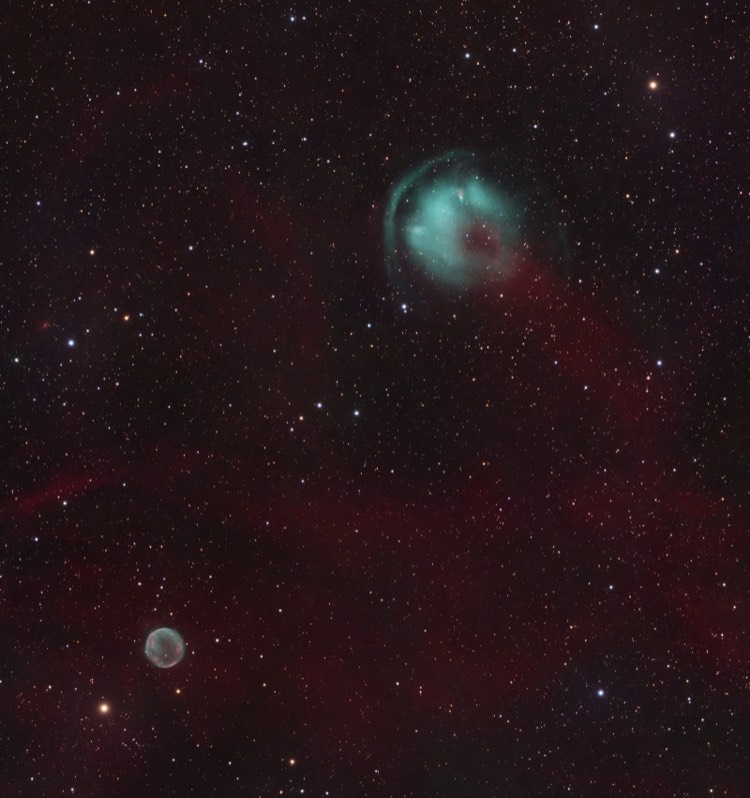Heckathorn-Fesen-Gull 1 (HFG1) and Abell 6
Published 21 Nov 2021

Links to other images and resolutions: HFG1fullres Abell 6 image crop Annotated image link
About this object
Heckathorn-Fesen-Gull 1 (HFG1) is a faint planetary nebula in Cassiopeia with a pronounced bow shock. HFG1 was discovered in 1982 and is also known as PK 136+05.1. HFG1 was formed by the mag 14.5 star V664 Case which is actually a binary star with a white dwarf and sun like component. These two stars are a few million kilometers apart and orbit each other every 14hrs. This pair is moving rapidly through the Milky Way and this rapid movement is causing the blue/green bow shock arc you can see in the image above. Opposite the direction of movement is a red tail of hydrogen gas.
Also within the image is the planetary nebula Abell 6. This planetary nebula is about 3 arc minutes in size and was discovered by George Abell in 1955. Its also blue/green due to doubly ionized oxygen (OIII) and has red hydrogen (HII) filaments. Abell 6 also goes by the designation PK 136+ 04.1.
The above image is cropped and rotated from the original field of view of the camera. Original image field of view at 50% resolution here: HFG1_50
Heckathorn-Fesen-Gull 1 (HFG1) is a faint planetary nebula in Cassiopeia with a pronounced bow shock. HFG1 was discovered in 1982 and is also known as PK 136+05.1. HFG1 was formed by the mag 14.5 star V664 Case which is actually a binary star with a white dwarf and sun like component. These two stars are a few million kilometers apart and orbit each other every 14hrs. This pair is moving rapidly through the Milky Way and this rapid movement is causing the blue/green bow shock arc you can see in the image above. Opposite the direction of movement is a red tail of hydrogen gas.
Also within the image is the planetary nebula Abell 6. This planetary nebula is about 3 arc minutes in size and was discovered by George Abell in 1955. Its also blue/green due to doubly ionized oxygen (OIII) and has red hydrogen (HII) filaments. Abell 6 also goes by the designation PK 136+ 04.1.
The above image is cropped and rotated from the original field of view of the camera. Original image field of view at 50% resolution here: HFG1_50
Image Details
- Optics : Stellarvue SVX 152T refractor @f8 1200mm FL
- Mount: Paramount MYT
- Camera: ZWO ASI6200
- Filters: Chroma 50mm RGBOIII, Astrodon 50mm Ha
- Exposure (min): RGBHaOIII 175:185:195:960:1020 Total of 42.25 hrs, 2x2 binning
- Automation Control: The Sky X, Voyager, PrimaluceLab Eagle 4
- Guiding: StarlightXpress Lodestar X2
- Processing Software: PixInsight, PS CC
- Location: Stark Bayou Observatory, Ocean Springs, MS
- Sky: Typical SQM 19.6-20.1, Bortle 5, Suburban
- Date: 7 Aug - 29 Oct 2021






